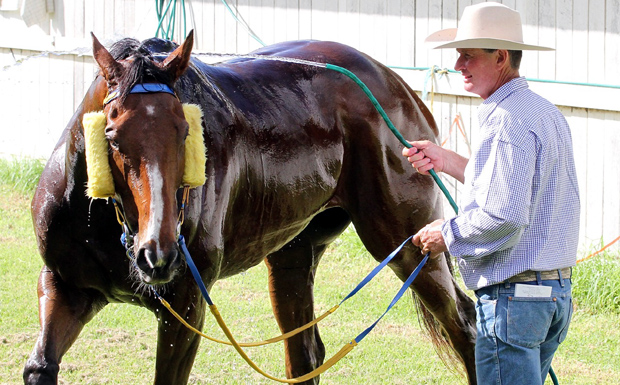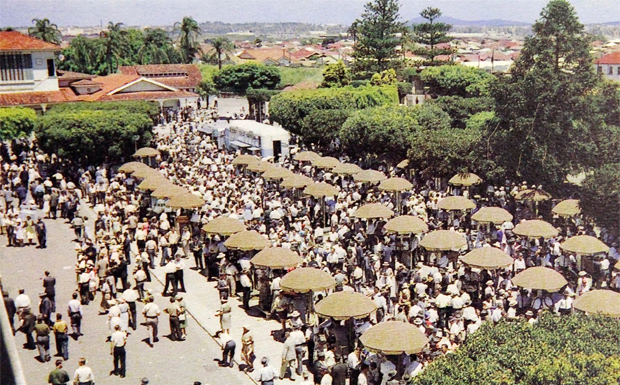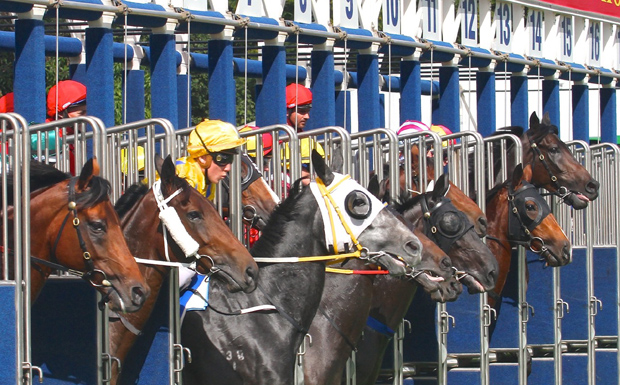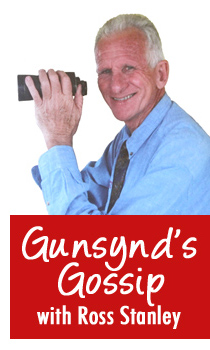
Wags were playing with words when they suggested that “She Will Rain” left her rivals in her wake in last week’s “Golden Galoshes” at Rosehill.
They were referring to the filly that reigned supreme in the Golden Slipper on an ultra-sodden surface.
On the corresponding card at Bundaberg, the theme partially continued when Clouds, a newcomer to Lindsay Anderson’s small Hivesville squad, put a dampener on all bar Craiglea Pistol (Hannah Phillips) in the Class B (850m).
Although a decisively beaten runner-up, the grey by Bradbury’s Luck from the Hurricane Sky mare Sky Bid was making its debut on the sand.
It was also the ex-Victorian’s first try in a clockwise direction, so it’s likely that improvement will follow.
Appropriately, Clouds, which is owned by Anderson, his wife Jodie and the Kilmore horsewoman Bronwen Upton, has strong form in the wet.
All four of the five-year-old’s podium placings to date have been recorded on soft or heavy tracks.
The sprinter’s previous best effort was a dead-heat for first in an 1100 metre Werribee maiden for the Lee and Shannon Hope team last May.
Upton, whose initial contact with Lindsay involved campdrafting horses, originally raced Clouds with his breeders, namely her parents Bill and Janice and her twin sister Stephanie.
Bronwen breaks in and educates thoroughbreds. She has worked for the likes of Terry Henderson, Simon O’Donnell’s OTI organisation, and Mark Kavanagh, and handled a daughter of the great Makybe Diva.
* * *
Meanwhile, Anderson is preparing for a racing and selling mission to Rockhampton shortly.
At Callaghan Park, Clouds and his old marvel Glenthorn Avenue are being asked to continue the stable’s astonishing run.
Since September 19, 2015 Anderson’s 50 starters have put together a 10-14-8-3 return.
That is an amazing strike rate in anybody’s terms. particularly when it was compiled by just five individual gallopers.
At the Capricornia Sales, lot 34 is the Andersons’ well bred filly by the T.J. Smith Stakes winner Master of Design from the Reset mare Checklist.
The yearling’s dam is a half sister to Tally, the Street Cry gelding that won the 2016 MVRC Alister Clark Stakes and the MRC Autumn Classic, and was placed in the Derby at Randwick, the VRC Turnbull Stakes and a VRC Lexus Handicap.
This offering carries the genes of Secretariat, Roberto, Nijinsky, Danehill, Redoute’s Choice, Zabeel and Sir Tristram.
Anderson has provided the sales with a previous top seller.
The son of Dash For Cash and his Exceed and Excel mare Letter From France was sold to Ross Donovan for $50,000.
Under the name Cash Dash, the gelding was a juvenile winner at Eagle Farm and the Sunshine Coast.
Anderson reported that the bay was then on-sold for $500,000 to Hong Kong.
Last Sunday, the now named Chung Wah Spirit ran a sterling second at Sha Tin in Class 3 grade.
Postscript: The value of the above-mentioned Lot 34 was enhanced on Saturday afternoon when Tally took out the $300,000 Mornington Cup.
* * *

Tracking The Track
No decent follower of racing would begrudge both Racing Queensland and the Brisbane Racing Club an immediate spree of good fortune.
An interaction of factors over the past ten months have made for very heavy going.
Firstly,the much anticipated re-opening of Eagle Farm was a frustrating disappointment.
Then the tragic deaths of two men working on the infield stabling project in October impacted on the construction, scheduling and building of the high-rise residential tower on the outer precinct, which had repercussions for the nearby trainer-tenants.
Officials who had weathered the storm of criticism about the Farm’s course proper were heartened late last year when there were signs that the worst may have passed.
Alas, after a recent meeting at Eagle Farm, a cross-sectional conference was arranged and the club’s chairman Neville Bell made the following statements to the Brisbane press:
“The way the track raced on Monday was clearly not acceptable. In November and December the track seemed to be going very well but in February and March it has gone the other way.
“We thought the only way forward was to have a meeting with all the experts.
“It’s fair to say it’s not one single thing. It’s a lot to do with the immaturity of the turf, the extreme weather conditions and the amount of racing we are doing on it.
“Flemington gets two months off after Stakes day. Caulfield gets two months after the Caulfield Cup. Our racing model up here doesn’t allow that sort of break.”
Bell added that Wednesday’s meeting convinced the board and himself that the track could live up to expectations in the future, but warned “there’s no quick fix to this”.
“The experts say the way it was planted, it’s going to be two years before it’s a mature plant. We just have to try and balance producing a good racing surface with growing the grass to maturity.”
* * *
Although it is little consolation, track problems such as bias are not new.
On the opening day of the Doomben racecourse on May 20, 1933 there was much discussion after the Newmarket Handicap, the event that was to develop into the Doomben 10,000.
The debate about fast and slow sides of the straight six furlongs course included an analysis of the barrier draw’s influence.
Recovery time for tracks was less of an issue up to the 1970s.
Midweek racing was confined to the likes of Gatton, Laidley, Oxenford, Southport, Esk, Kilcoy and Beaudesert, while Saturday and public holiday fixtures were held at Eagle Farm, Doomben, Bundamba (Ipswich) and Albion Park.
By the way, Doomben lost the top part of its straight when a section was resumed for wartime aerodrome needs.
* * *

High Hopes For Winter Carnival
The three key sprints at the forthcoming local winter carnival are the $700,000 James Boag’s Premium Doomben 10,000 (1200m, May 13), the $700,000 Darley Kingsford-Smith Cup (1350m, May 27) and the $1m UBET Stradbroke Handicap (1400m, June 10).
Staging the latter pair at Eagle Farm and reducing the 10,000’s prizemoney and distance is a significant amendment to the carnival.
Proponents of the alteration will be desperately wishing for a successful switch.
Furthermore, some of the stables planning a Queensland visit will probably keep a monitoring eye on the way the two key courses play in the lead up.

























It was nice reminiscing on seeing the photo of bookmakers and punters at Eagle Farm in the area known as the Leger mainly following World War II through the late 40s, 50s and 60s when patrons attended meetings by trams and buses and when vehicles were very rarely seen as the likes of today. As there was no tote betting, bookmakers were at a premium overflowing from the two main rings in the Paddock position in two locations surrounding the grandstands. There were three entry positions, the top admission price was to the Paddock, the second to the Leger (which was great for moderate punters) and third to the Flat which necessitated a walk across the main track to the opposite side. As a 12-year-old I recalled my uncle paying 3d for my entry and sometimes mid-week it was free. During that period, in the Paddock, Leger and Flat there were over 60 bookmakers operating. Now with the advancement of tote betting and the availability of the TAB network throughout hundreds of hotels and other venues, plus the emergence of off-course betting venues for telephone investments, the crowds have dwindled dramatically. This applies especially to mid-week meetings when on some occasions there maybe just up to six operating. It’s sad in many ways because most bookies added that special flair with continual changing prices and in most instances were top gentlemen.